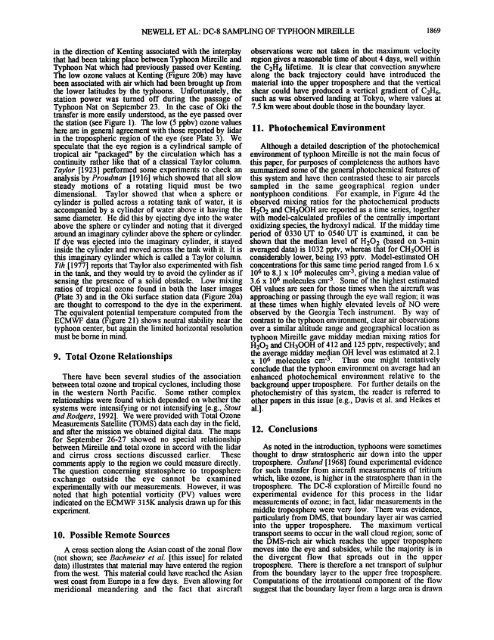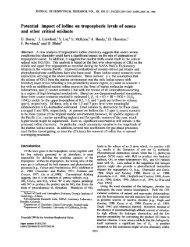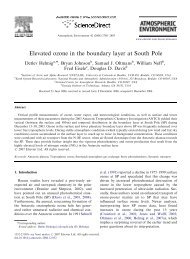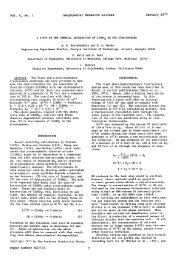Atmospheric sampling of Supertyphoon Mireille with NASA ...
Atmospheric sampling of Supertyphoon Mireille with NASA ...
Atmospheric sampling of Supertyphoon Mireille with NASA ...
Create successful ePaper yourself
Turn your PDF publications into a flip-book with our unique Google optimized e-Paper software.
NEWELL ET AL: DC-8 SAMPLING OF TYPHOON MIREILLE 1869<br />
in the direction <strong>of</strong> Kenting associated <strong>with</strong> the imerplay observations were not taken in the maximum velocity<br />
that had been taking place between Typhoon <strong>Mireille</strong> and region gives a reasonable time <strong>of</strong> about 4 days, well <strong>with</strong>in<br />
Typhoon Nat which had previously passed over Kenting. the C2H6 lifetime. It is clear that convection anywhere<br />
The low ozone values at Kenting (Figure 20b) may have along the back trajectory could have introduced the<br />
been associated <strong>with</strong> air which had been brought up from material into the upper troposphere and that the vertical<br />
the lower latitudes by the typhoons. Unfortunately, the<br />
station power was turned <strong>of</strong>f during the passage <strong>of</strong><br />
Typhoon Nat on September 23. In the case <strong>of</strong> Oki the<br />
transfer is more easily understood, as the eye passed over<br />
shear could have produced a vertical gradient <strong>of</strong> C2H6,<br />
such as was observed landing at Tokyo, where values at<br />
7.5 km were about double those in the boundary layer.<br />
the station (see Figure 1). The low (5 ppbv) ozone values<br />
here are in general agreement <strong>with</strong> those reported by lidar<br />
11. Photochemical Environment<br />
in the tropospheric region <strong>of</strong> the eye (see Plate 3). We<br />
speculate that the eye region is a cylindrical sample <strong>of</strong> Although a detailed description <strong>of</strong> the photochemical<br />
tropical air "packaged" by the circulation which has a environment <strong>of</strong> typhoon <strong>Mireille</strong> is not the main focus <strong>of</strong><br />
continuity rather like that <strong>of</strong> a classical Taylor column. this paper, for purposes <strong>of</strong> completeness the authors have<br />
Taylor [1923] performed some experiments to check an summarized some <strong>of</strong> the general photochemical features <strong>of</strong><br />
analysis by Proudman [1916] which showed that all slow this system and have then comrasted these to air parcels<br />
steady motions <strong>of</strong> a rotating liquid must be two sampled in the same geographical region under<br />
dimensional. Taylor showed that when a sphere or nontyphoon conditions. For example, in Figure 4d the<br />
cylinder is pulled across a rotating tank <strong>of</strong> water, it is observed mixing ratios for the photochemical products<br />
accompanied by a cylinder <strong>of</strong> water above it having the H202 and CH3OOH are reported as a time series, together<br />
same diameter. He did this by ejecting dye into the water <strong>with</strong> model-calculated pr<strong>of</strong>iles <strong>of</strong> the centrally important<br />
above the sphere or cylinder and noting that it diverged oxidizing species, the hydroxyl radical. If the midday time<br />
around an imaginary cylinder above the sphere or cylinder. period <strong>of</strong> 0330 UT to 0540 UT is examined, it can be<br />
If dye was ejected into the imaginary cylinder, it stayed shown that the median level <strong>of</strong> H20 2 (based on 3-min<br />
inside the cylinder and moved across the tank <strong>with</strong> it. It is averaged data) is 1032 pptv, whereas that for CH3OOH is<br />
this imaginary cylinder which is called a Taylor column. considerably lower, being 193 pptv. Model-estimated OH<br />
Yih [1977] reports that Taylor also experimemed <strong>with</strong> fish concentrations for this same time period ranged from 1.6 x<br />
in the tank, and they would try to avoid the cylinder as if 106 to 8.1 x 106 molecules cm -3, giving a median value <strong>of</strong><br />
sensing the presence <strong>of</strong> a solid obstacle. Low mixing 3.6 x 106 molecules cm '3. Some <strong>of</strong> the highest estimated<br />
ratios <strong>of</strong> tropical ozone found in both the laser images OH values are seen for those times when the aircraft was<br />
(Plate 3) and in the Oki surface station data (Figure 20a) approaching or passing through the eye wall region; it was<br />
are thought to correspond to the dye in the experiment. at these times when highly elevated levels <strong>of</strong> NO were<br />
The equivalent potential temperature computed from the observed by the Georgia Tech instrument. By way <strong>of</strong><br />
ECMWF data (Figure 21) shows neutral stabili .ty near the contrast to the typhoon environment, clear air observations<br />
typhoon center, but again the linfited horizontal resolution over a similar altitude range and geographical location as<br />
must be borne in mind.<br />
9. Total Ozone Relationships<br />
typhoon <strong>Mireille</strong> gave midday median mixing ratios for<br />
H202 and CH3OOH <strong>of</strong> 412 and 125 pptv, respectively; and<br />
the av, erage midday median OH level was estimated at 2.1<br />
x 10 ø molecules cm '3. Thus one might tentatively<br />
There have been several studies <strong>of</strong> the association<br />
between total ozone and tropical cyclones, including those<br />
in the western North Pacific. Some rather complex<br />
relationships were found which depended on whether the<br />
systems were intensifying or not intensifying [e.g., Stout<br />
and Rodgers, 1992]. We were provided <strong>with</strong> Total Ozone<br />
conclude that the typhoon environment on average had an<br />
enhanced photochemical environment relative to the<br />
background upper troposphere. For further details on the<br />
photochemistry <strong>of</strong> this system, the reader is referred to<br />
other papers in this issue [e.g., Davis et al. and Heikes et<br />
Measurements Satellite (TOMS) data each day in the field,<br />
and after the mission we obtained digital data. The maps<br />
12. Conclusions<br />
for September 26-27 showed no special relationship<br />
between <strong>Mireille</strong> and total ozone in accord <strong>with</strong> the lidar As noted in the introduction, typhoons were sometimes<br />
and cirrus cross sections discussed earlier. These thought to draw stmtospheric air down into the upper<br />
comments apply to the region we could measure directly. troposphere. Ostlund [1968] found experimemal evidence<br />
The question concerning stratosphere to troposphere for such transfer from aircraft measurements <strong>of</strong> tritium<br />
exchange outside the eye cannot be examined which, like ozone, is higher in the stratosphere than in the<br />
experimentally <strong>with</strong> our measurements. However, it was troposphere. The DC-8 exploration <strong>of</strong> <strong>Mireille</strong> found no<br />
noted that high potential vorticity (PV) values were experimental evidence for this process in the lidar<br />
indicated on the ECMWF 315K analysis drawn up for this measurements <strong>of</strong> ozone; in fact, lidar measurements in the<br />
experiment.<br />
middle troposphere were very low. Them was evidence,<br />
particularly from DMS, that boundary layer air was carded<br />
into the upper troposphere. The maximum vertical<br />
10. Possible Remote Sources<br />
transport seems to occur in the wall cloud region; some <strong>of</strong><br />
the DMS-rich air which reaches the upper troposphere<br />
A cross section along the Asian coast <strong>of</strong> the zonal flow moves into the eye and subsides, while the majority is in<br />
(not shown; see Bachmeier et al. [this issue] for related the divergent flow that spreads out in the upper<br />
data) illustrates that material may have entered the region<br />
from the west. This material could have reached the Asian<br />
troposphere. There is therefore a net transport <strong>of</strong> sulphur<br />
from the boundary layer to the upper free troposphere.<br />
west coast from Europe in a few days. Even allowing for<br />
meridional meandering and the fact that aircraft<br />
Computations <strong>of</strong> the irrotational component <strong>of</strong> the flow<br />
suggest that the boundary layer from a large area is drawn






